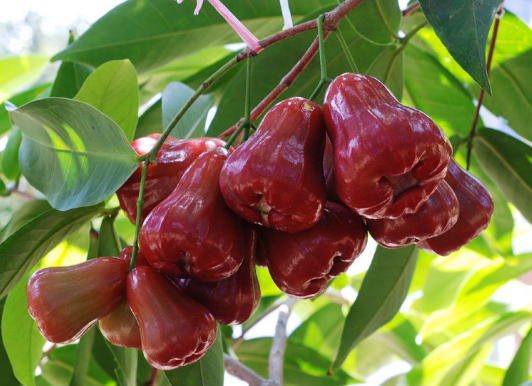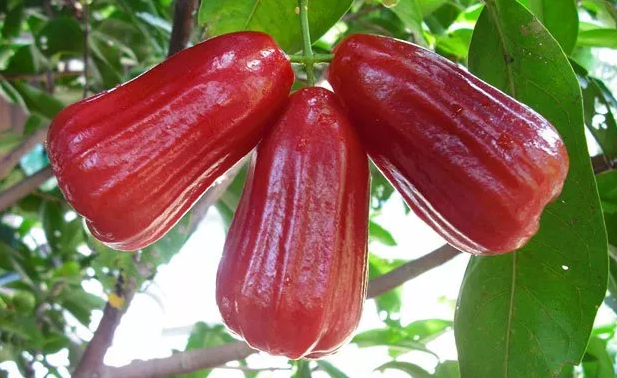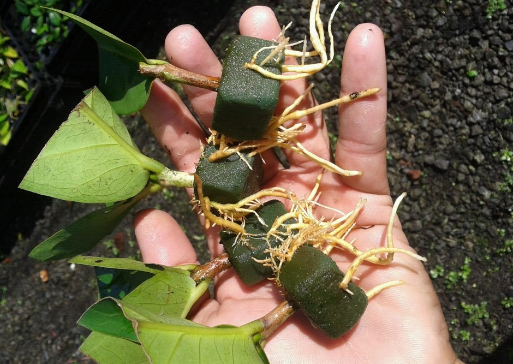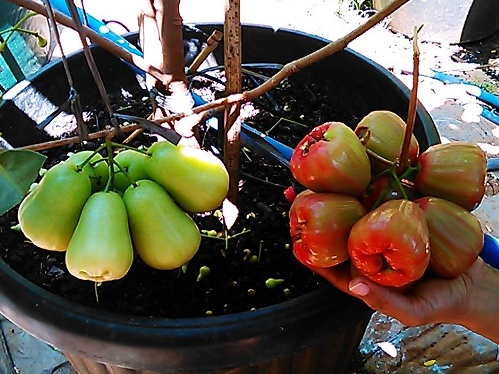Water guava fruit with the name Dhegus - "The beauty of the guava is Degus, short for Gede(big) and Bagus(nice), as the name implies the appearance of the guava fruit is quite large with an attractive dark red fruit skin color, sweet and crispy flavor coupled with thick fruit flesh and a tambourized fruit shape similar to , an appearance that has a beautiful impression is the advantage of the beautiful Guava Degus. "
Degus guava is the name given by Mr. Ir. Soedarmo, former Bojonegoro District Agricultural Extension, and he was known by the nickname Mbah Darmo because he was a senior Agricultural Extension in East Java, most recently as East Java Agriculture Extension Coordinator. He was the first to spread this guava plant in East Java, including several locations around the Pohjentrek Pasuruan Seed Horticultural Motherhouse, which was then one of those planted at the Horticulture BBI was selected as the Mother Tree and was released by the Minister of Agriculture in 2006 with Decree No .339 / KPTS / SR.120 / 5/2006.
Water guava fruit with the name Dhegus | Indonesian Fruits
Degus guava can grow anywhere, from the lowlands to an altitude of 1000 m above sea level, but ideally to be able to produce optimally should be planted in low land with a height of not more than 400 m above sea level. With low rainfall of 500-1000 mm / year with a number of rainy days of 50-70 days / year or dry areas with a dry season of more than 4 months.
This juice can be cultivated either in pots or called Tabulapot, planted in the yard or tabulakar and also on a large scale which requires a special area for business success, for this reason it is necessary to consider the nature and conditions of growth and infrastructure available in the planting location.
1. Propagation of seeds / seeds
Propagation of degus water guava can be done by grafting, connecting, grafting and seeding. The choice of propagation method is adjusted to the requirements, the time conditions for the costs and the available technical personnel. Seed propagation is quite successful and the most appropriate is by grafting and grafting from the parent tree. For seed multiplication, it is produced by seed producers who have been registered at the Seed Certification and Monitoring Center (BPSB) with labeled seed production.
2. Planting
The spacing of the planting of degus water guava planted in the garden widely, the spacing between trees is at least 5 x 5 m. With this spacing, then in 1 hectare it takes 400 seeds plus 10% as a substitute for seeds that may not grow or die.
- Preparation of planting holes
Planting holes should be prepared as much as possible 2 weeks before planting. The hole is made by means of the soil excavated with a size of 60x60x60 cm. The upper part of the soil (30 cm thick) is separated from the bottom soil, within 2 weeks, the hole is left to the sun.
- Planting
When planting seeds. holes filled with sand 2/6 parts, 3/6 parts filled with fertile soil / top soil excavation after clearing of grass seeds, then the seeds are planted after the plastic packaging has been removed, the top layer is given manure as a basic fertilizer 1/6 parts (+ 10 kg).
3. Maintenance
- Sprinkling
If there is no rain for 2 weeks after planting it needs to be watered twice a day, the rest is only once a day. After the plants grow, watering is no longer needed because the roots of the plants have penetrated the soil far enough to get enough water even though the surface of the soil seems dry, on the contrary to avoid excess water, during the rainy season, plants need to be drained around it.
- Weeding
Weeding is done with the aim of removing bully plants (weeds), wild grasses and vines that often grow around plants can interfere with growth, especially when the plants are still small, aged 1- 3 years. When cleaning weeds, it can also be done weeding around the plants at least twice a year weeding and roasting.
- Advanced Fertilizer Giving
Fertilization is the right choice so that the degus water guava plant can produce better. Provision of artificial fertilizer is carried out twice a year and manure is given once a year, before the dry season of the dry season. Fertilizer dosage is adjusted to the age of the plant.
- Stitching
Seedlings that do not grow or die must be immediately refined, namely replacing dead seeds with new ones. Late embroidering will make plants grow not as big.
- Trimming
Maintenance pruning is done on branches, branches and twigs that are dry, dead, wounded, old, broken, and other parts of plants that are not perfectly growth. Pruning is also done on branches that overlap, growing irregularly so that the main branch is defeated. Branches that are sick or old but still productive enough are not cut out, but are left about 5 cm from the base. Crops that are too dense are also trimmed to avoid fungus coming.
4. Pest Control Disease
From the inventory of pests and diseases that attack degus water guava, there are several types of attacks that need attention. Symptoms of attack from each type are as follows:
- Atlas moth (Attacus atlas)
The caterpillars are very greedy for eating leaves. Control by collecting eggs, caterpillars and cocoons to be destroyed and spray contact insecticides.
- Soft green scale (Coccus viridis (Green))
Causes of black fungus such as soot. Control of natural ways is eaten by several kinds of ladybugs. These fleas in the rainy season can be destroyed by fungus attacks, chemical control using contact insecticides.
- Bactrocera (Bactrocera sp.)
The genus name is derived from Ancient Greek bakter "rod" and kera "horn". This fly puts the eggs in the flesh, so after hatching the larvae eat the degus guava fruit. The use of Methyl eugenol and hydrolizate protein combined with insecticides.
- Root and Fruit Fungus
The rot in the root is caused by water flooding that is too long, causing rotting to the roots. The rot on this fruit is due to pest bite so that the fungus causes the fruit to fall out and rot. Control by improving soil aeration and fruit wrapping, as well as spraying insecticides and fungicides such as thiodan and dithane.
Cultivation of Dhegus guava can also be done by:
1. Cultivation of fruit plants in pots
Cultivation of fruit plants in pots or more popularly called tabulapot is basically planting fruit trees using pot plant media. The stages that need to be known:
- Bibit is taken from the polybag packaging / media carefully so as not to damage the roots, so that the plants do not die.
- Bibits are placed in the center of the hole as deep as the root neck. If you plant too much, the body will be less good.
- Before being planted, the leaves are cut in half to reduce evaporation of water because the roots cannot absorb enough water from the soil.
Certain recipes to optimize the guava juice of Degus water include:
- A suitable and optimal pot size used is usually 30-70 cm in diameter with a height of 40-50 cm.
- Media planting a mixture of soil, sand, and manure 1: 1: 1 ratio.
- First fertilization 1: 4: 2 Urea, SP36, and NPK 50 gr perpot at 2-3 months old, repeated every 3 months.
- Flowering stimulation using ZPT such as Atonik.
Tabulapot guava, Degus water, besides being able to provide vitamins or fruit for the family, this tabulapot also has more value on its figure, red fruit clustered together with ornamental plants in the yard will look beautiful to look at.
2. Cultivation of fruit plants in the yard
In principle, the cultivation of fruit plants in the yard is the same as the treatment and technical planting, but there are certain things to note, namely:
- The location or location of planting must be considered.
- Lighting continuity is not interrupted.
- Not disturbing or covering the building nearby.
- Plant maintenance is expected to need consistent attention, do not let the plants become shrubs once.
- Fertilization is done by using manure and artificial fertilizers such as urea, TSP, KCL. Every year the dose is added.
The method of planting in this yard does require a small yard which is eligible for shrubs. The production of guava Degus in this yard is more than the tabulapot. This is indeed expected for the needs of family fruits, as well as additional income when sold.
source:
bbppketindan.bppsdmp.pertanian.go.id
















0 comments: